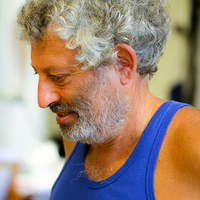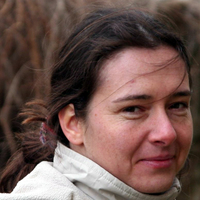
simon davis
Phone: 00 351 21 362 6328
Address: LARC, Rua da Bica do Marquês 2, Ajuda, Lisbon, Portugal
Address: LARC, Rua da Bica do Marquês 2, Ajuda, Lisbon, Portugal
less
Related Authors
Erika Gál
Hungarian Academy of Sciences
Arthur E Bogan
North Carolina State Museum of Natural Sciences
Masafumi Matsui
Kyoto University
Amalio Santacruz-Varela
Colegio de Postgraduados
Songul sever mutlu
Akdeniz University








Uploads
Papers by simon davis
• The timing and reason for the demise of the native animals – the pygmy hippopotamuses and pygmy elephants – is still not known. My preferred explanation is that these animals, presumably naïve, and therefore easy to hunt, became extinct very rapidly so that any traces of their remains in any archaeological site will be hard to find. People undoubtedly hunted them and it is also quite likely that they suffered competition from feral pigs and other animals introduced from the mainland Near East some 10 or 11 millennia ago.
• Given the identity of the Cypriot fallow deer and the former distribution of fallow deer taxa on the mainland as well as considerations of the sizes of domesticated pigs in the Near East it seems probable that the first human colonists came to the island from the north-eastern corner of the Mediterranean rather than from western Anatolia, Greece or the southern Levant.
• Throughout their occupation, the inhabitants of Khirokitia appear to have possessed a reduced spectrum of animals. This suggests, as do their cultural remains, development in isolation. In other words over time there is little evidence for much contact with peoples and cultures of the mainland.
• The reason for the absence of cattle from Khirokitia and other contemporary sites during later Aceramic Neolithic times also remains an enigma. Did the early Cypriots tire of cattle herding and decide to concentrate on smaller livestock like sheep, goat and pigs? Or did the cattle succumb to some kind of disease? It is likely that we shall never know.
• Well over 99% of the medium and large mammal remains from Khirokitia belonged to sheep, goat, Mesopotamian fallow deer and pigs; with dog, cat, and fox present in very small numbers (these last three were almost certainly not eaten). The presence of mouse and shrew is also attested. The frequencies of the sheep, goat, deer and pig change in a most interesting way. Thus in the beginning, and as at the earlier settlement of Shillourokambos, goats were quite common but rapidly became rare in the course of the occupation of Khirokitia. Sheep increased through time while there was a simultaneous and gradual reduction in the frequencies of pig and fallow deer – two animals that prefer woodland and moist vegetation. One possible explanation for these changes is that they reflect local habitat deterioration – a destruction of local forests – an explanation corroborated by the palaeo-botanical remains from the site. It is possible that trees were cut down to provide building material and fuel. The early switch from goat to sheep may reflect specialisation or a preference for grazing livestock on the Khirokitia plain.
• During the course of the site’s occupation there is little evidence for any size change of the fallow deer. The deer from Shillourokambos may have been very slightly smaller. Similarly the pigs and perhaps the goats too (though there are really too few goat bones to be very sure) remained similar in size. This stasis contrasts with what happened to the sheep. Sheep increased in size in the course of the occupation of the site. This probably happened gradually and without any change of shape of the bones (or at least the astragalus). It therefore seems logical to assume, but this cannot be proven, that sheep underwent some kind of local change. Perhaps they were improved by the inhabitants of Khirokitia to provide larger carcasses and more meat. This size increase at Khirokitia contrasts with the contemporary trend in mainland (Syrian) sheep which decreased in size. This could again signal local development in isolation from the mainland. A consideration of the variation of sheep, goat, fallow deer and pig tooth and bone measurements also fails to reveal any change over time.
• In two other respects we see stasis occurring for all four of the common large animals at Khirokitia. Thus both the representation of parts of their carcass and their age-at-slaughter remained the same throughout the occupation of the site. One interesting exception is a particular locus that contained an excess of distal femora – perhaps evidence for some ritual practise or children making a collection of these bones.
• Variations of the average sizes of the samples of bones of fallow deer between layers are shown to reflect biases in the representation of the sexes – this animal being markedly sexually dimorphic. With large samples of measurable bones it has also been possible to use and develop metric methods for separating sheep from goat bones. The astragalus has proven particularly useful in this respect and shape variation of the astragalus may well provide useful avenues of study in the future.
• Although difficult to speculate about actual husbandry practises, the chronological size increase of the sheep possibly reflects their improvement. Similarly some very sparse sex and age related data for the goat could be interpreted in terms of a change in the way goats were husbanded. As for pigs and fallow deer there is little to indicate any change in the relationship of people towards these animals in the course of Khirokitia’s occupation. Indeed it is difficult to understand whether fallow deer were hunted or kept in enclosures (or both). Given the fairly high proportion of caprines slaughtered while still osteologically immature, it is most probable that the sheep as well as the pigs were kept mainly for their meat.
The animal remains from Aceramic Neolithic Cyprus when viewed in a more general geographic context – the Near East as a whole – provide us with evidence for what must be almost the earliest sign of man’s possession of domesticated food animals like the pig, cattle, sheep and goat and presumably the taming of foxes, cats and fallow deer. As Vigne has noted at Shillourokambos, some of these animals were undoubtedly hunted. This makes it likely that some escaped into the wild to establish feral populations which could be hunted too. When viewed in a wider geographical perspective it is becoming clear that while a decrease in size of animals like Sus, Ovis and Bos certainly signals their early domestication, size continued to decrease perhaps for one or several millennia after domestication. Put another way, the effects of domestication took some time to become apparent. Another example of this is the shape of the Khirokitia Sus lower third molars: they are intermediate between wild Near Eastern examples and domesticated pigs from Medieval England. It is hoped that this report and the data herein will serve zooarchaeologists in the future and aid our understanding of animals and man-animal relations in Cyprus.
• The timing and reason for the demise of the native animals – the pygmy hippopotamuses and pygmy elephants – is still not known. My preferred explanation is that these animals, presumably naïve, and therefore easy to hunt, became extinct very rapidly so that any traces of their remains in any archaeological site will be hard to find. People undoubtedly hunted them and it is also quite likely that they suffered competition from feral pigs and other animals introduced from the mainland Near East some 10 or 11 millennia ago.
• Given the identity of the Cypriot fallow deer and the former distribution of fallow deer taxa on the mainland as well as considerations of the sizes of domesticated pigs in the Near East it seems probable that the first human colonists came to the island from the north-eastern corner of the Mediterranean rather than from western Anatolia, Greece or the southern Levant.
• Throughout their occupation, the inhabitants of Khirokitia appear to have possessed a reduced spectrum of animals. This suggests, as do their cultural remains, development in isolation. In other words over time there is little evidence for much contact with peoples and cultures of the mainland.
• The reason for the absence of cattle from Khirokitia and other contemporary sites during later Aceramic Neolithic times also remains an enigma. Did the early Cypriots tire of cattle herding and decide to concentrate on smaller livestock like sheep, goat and pigs? Or did the cattle succumb to some kind of disease? It is likely that we shall never know.
• Well over 99% of the medium and large mammal remains from Khirokitia belonged to sheep, goat, Mesopotamian fallow deer and pigs; with dog, cat, and fox present in very small numbers (these last three were almost certainly not eaten). The presence of mouse and shrew is also attested. The frequencies of the sheep, goat, deer and pig change in a most interesting way. Thus in the beginning, and as at the earlier settlement of Shillourokambos, goats were quite common but rapidly became rare in the course of the occupation of Khirokitia. Sheep increased through time while there was a simultaneous and gradual reduction in the frequencies of pig and fallow deer – two animals that prefer woodland and moist vegetation. One possible explanation for these changes is that they reflect local habitat deterioration – a destruction of local forests – an explanation corroborated by the palaeo-botanical remains from the site. It is possible that trees were cut down to provide building material and fuel. The early switch from goat to sheep may reflect specialisation or a preference for grazing livestock on the Khirokitia plain.
• During the course of the site’s occupation there is little evidence for any size change of the fallow deer. The deer from Shillourokambos may have been very slightly smaller. Similarly the pigs and perhaps the goats too (though there are really too few goat bones to be very sure) remained similar in size. This stasis contrasts with what happened to the sheep. Sheep increased in size in the course of the occupation of the site. This probably happened gradually and without any change of shape of the bones (or at least the astragalus). It therefore seems logical to assume, but this cannot be proven, that sheep underwent some kind of local change. Perhaps they were improved by the inhabitants of Khirokitia to provide larger carcasses and more meat. This size increase at Khirokitia contrasts with the contemporary trend in mainland (Syrian) sheep which decreased in size. This could again signal local development in isolation from the mainland. A consideration of the variation of sheep, goat, fallow deer and pig tooth and bone measurements also fails to reveal any change over time.
• In two other respects we see stasis occurring for all four of the common large animals at Khirokitia. Thus both the representation of parts of their carcass and their age-at-slaughter remained the same throughout the occupation of the site. One interesting exception is a particular locus that contained an excess of distal femora – perhaps evidence for some ritual practise or children making a collection of these bones.
• Variations of the average sizes of the samples of bones of fallow deer between layers are shown to reflect biases in the representation of the sexes – this animal being markedly sexually dimorphic. With large samples of measurable bones it has also been possible to use and develop metric methods for separating sheep from goat bones. The astragalus has proven particularly useful in this respect and shape variation of the astragalus may well provide useful avenues of study in the future.
• Although difficult to speculate about actual husbandry practises, the chronological size increase of the sheep possibly reflects their improvement. Similarly some very sparse sex and age related data for the goat could be interpreted in terms of a change in the way goats were husbanded. As for pigs and fallow deer there is little to indicate any change in the relationship of people towards these animals in the course of Khirokitia’s occupation. Indeed it is difficult to understand whether fallow deer were hunted or kept in enclosures (or both). Given the fairly high proportion of caprines slaughtered while still osteologically immature, it is most probable that the sheep as well as the pigs were kept mainly for their meat.
The animal remains from Aceramic Neolithic Cyprus when viewed in a more general geographic context – the Near East as a whole – provide us with evidence for what must be almost the earliest sign of man’s possession of domesticated food animals like the pig, cattle, sheep and goat and presumably the taming of foxes, cats and fallow deer. As Vigne has noted at Shillourokambos, some of these animals were undoubtedly hunted. This makes it likely that some escaped into the wild to establish feral populations which could be hunted too. When viewed in a wider geographical perspective it is becoming clear that while a decrease in size of animals like Sus, Ovis and Bos certainly signals their early domestication, size continued to decrease perhaps for one or several millennia after domestication. Put another way, the effects of domestication took some time to become apparent. Another example of this is the shape of the Khirokitia Sus lower third molars: they are intermediate between wild Near Eastern examples and domesticated pigs from Medieval England. It is hoped that this report and the data herein will serve zooarchaeologists in the future and aid our understanding of animals and man-animal relations in Cyprus.
Archaeological excavations undertaken between 1997 and 2010 at Lapa dos Coelhos – a small cavity in the Almonda River karst system near Torres Novas, Portugal, indicated intermittent occupation by humans during the Upper Pleistocene. During the Magdalenian the site served as a specialized temporary camp, probably related to hunting and fishing activities. A ‘laurel leaf’ fragment suggests human occupation during the Solutrean. The Mousterian artefacts identified in the lowest layers may correspond to runoff from other galleries of the same karstic system. Interpretation of the faunal remains shows that during the earlier periods the site also served as a hyaena den. We also note an important increase of small animals, especially rabbits, during the Tardiglacial period which probably reflects the ‘Mesolithic Crisis’. The Capra was considerably larger than modern ibex from Andalucia and modern domestic goats. A difference that may reflect climate change at the end of the Pleistocene.
Resumo
Os trabalhos arqueológicos, empreendidos entre 1997 e 2010, nesta pequena cavidade do sistema cársico do rio Almonda (Torres Novas, Portugal), permitiram identificar a ocupação humana intermitente da cavidade durante o pleistocénico superior. Durante o Magdalenense o local terá funcionado como acampamento temporário especializado, provavelmente relacionado com apoio a actividades cinegéticas. A recolha de um fragmento de folha de loureiro documenta a ocupação humana do local durante o Solutrense. Os materiais líticos atribuíveis
ao Moustierense, podem corresponder a escorrências provenientes de outras galerias, do mesmo sistema cársico. O estudo da fauna permitiu concluir que durante os períodos mais antigos o sítio serviu, igualmente,
como covil de hiena e constatar o aumento de consumo de animais de pequeno porte, sobretudo coelho, durante o Tardiglaciar.